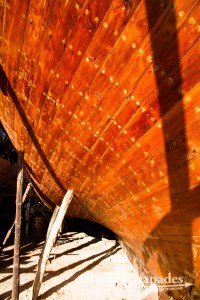Dhows have been plying the oceans for thousands of years, taking Arab traders to India and as far as China. The city of Sur has a long tradition of building these wooden vessels, especially the very big ones, called Ghanjah. Of course, nowadays modern container ships do the job, but dhows have not disappeared and the dhow shipyard in Sur is the largest of all the Arabian countries.
We were a bit hesitant – was it okay to simply walk in? None of the builders hammering and sawing away on two big dhows seemed to pay any attention, so we started exploring the place. We walked away with the conclusion that building a dhow in Sur still involves very little machinery, but a century old expertise and that the title “The largest dhow shipyard” must be a matter of perspective.
In 1980, Sur enjoyed a brief spell of glory. To illustrate the Golden Age (8-11th century) of Omani seafaring, the government sponsored a project that aimed high: building a dhow by using only traditional building methods and material. And above all no nails could be used. Why no nails? The Sohar (the dhow’s very name) was to retrace the voyage of Sindbad the Sailor to China, as told in the collection of 1001 Nights. Sindbad’s adventures included passing a magnet mountain that would pull all the metal from a ship and sink it. With the help of 30 Omani master builders, the dhow was built within six months. It took another seven months to cover the 6.000 nautical mile trip China. To top things, the captain was an Irish explorer, who used only ancient tools for navigation. The crew became famous, a book was written, a film produced and every child in Sur knows that story.
Sur’s other attraction is its very well – hidden Maritime Museum, old photos and tools that portray the history of seafaring in this city. Simply the challenge of finding it put us in such an elated state that it felt like exploring the Louvre, not a tiny museum next to a soccer field…


No comments yet.